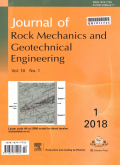- 钛学术文献服务平台 \
- 学术期刊 \
- 基础科学期刊 \
- 天文学、地球科学期刊 \
- 岩石力学与岩土工程学报(英文版)期刊 \
Kriging-based reliability analysis of the long-term stability of a deep drift constructed in the Callovo-Oxfordian claystone
Kriging-based reliability analysis of the long-term stability of a deep drift constructed in the Callovo-Oxfordian claystone
基本信息来源于合作网站,原文需代理用户跳转至来源网站获取
摘要:
Callovo-Oxfordian (COx) claystone has been considered as a potential host rock for geological radioactive waste disposal in France (Cigéo project). During the exploitation phase (100 years), the stability of drifts (e.g. galleries/alveoli) within the disposal is assured by the liner, which includes two layers:concrete arch segment and compressible material. The latter exhibits a significant deformation capacity (about 50%) under low stress (<3 MPa). Although the response of these underground structures can be governed by complex thermo-hydro-mechanical coupling, the creep behavior of COx claystone has been considered as the main factor controlling the increase of stress state in the concrete liner and hence the long-term stability of drifts. Therefore, by focusing only on the purely mechanical behavior, this study aims at investigating the uncertainty effect of the COx claystone time-dependent properties on the stability of an alveolus of Cigéo during the exploitation period. To describe the creep behavior of COx claystone, we use Lemaitre's viscoplastic model with three parameters whose uncertainties are identified from laboratory creep tests. For the reliability analysis, an extension of a well-known Kriging metamodeling technique is proposed to assess the exceedance probability of acceptable stress in the concrete liner of the alveolus. The open-source code Code_Aster is chosen for the direct numerical evaluations of the performance function. The Kriging-based reliability analysis elucidates the effect of the uncertainty of COx claystone on the long-term stability of the concrete liner. Moreover, the role of the compressible material layer between the concrete liner and the host rock is also highlighted.

推荐文章
The use of in-situ cosmogenic 21Ne in studies on long-term landscape development
Cosmogenic nuclides
21Ne
Long timescale
Landscape evolution
A re-assessment of nickel-doping method in iron isotope analysis on rock samples using multi-collect
Fe isotope
Ni-doping
Stable isotope
Precision and accuracy
Mass bias correction
Pseudo-high mass resolution
内容分析
关键词云
关键词热度
相关文献总数
(/次)
(/年)
文献信息
| 篇名 | Kriging-based reliability analysis of the long-term stability of a deep drift constructed in the Callovo-Oxfordian claystone | ||
| 来源期刊 | 岩石力学与岩土工程学报(英文版) | 学科 | |
| 关键词 | |||
| 年,卷(期) | 2021,(5) | 所属期刊栏目 | |
| 研究方向 | 页码范围 | 1033-1046 | |
| 页数 | 14页 | 分类号 | |
| 字数 | 语种 | 英文 | |
| DOI | |||
五维指标
引文网络
引文网络
二级参考文献 (168)
共引文献 (8)
参考文献 (30)
节点文献
引证文献 (0)
同被引文献 (0)
二级引证文献 (0)
1967(1)
- 参考文献(0)
- 二级参考文献(1)
1973(2)
- 参考文献(1)
- 二级参考文献(1)
1975(1)
- 参考文献(0)
- 二级参考文献(1)
1976(1)
- 参考文献(0)
- 二级参考文献(1)
1977(1)
- 参考文献(0)
- 二级参考文献(1)
1978(1)
- 参考文献(0)
- 二级参考文献(1)
1979(1)
- 参考文献(1)
- 二级参考文献(0)
1983(1)
- 参考文献(0)
- 二级参考文献(1)
1984(1)
- 参考文献(0)
- 二级参考文献(1)
1985(4)
- 参考文献(0)
- 二级参考文献(4)
1986(1)
- 参考文献(0)
- 二级参考文献(1)
1987(3)
- 参考文献(0)
- 二级参考文献(3)
1988(1)
- 参考文献(0)
- 二级参考文献(1)
1990(4)
- 参考文献(0)
- 二级参考文献(4)
1991(1)
- 参考文献(0)
- 二级参考文献(1)
1994(1)
- 参考文献(0)
- 二级参考文献(1)
1995(2)
- 参考文献(0)
- 二级参考文献(2)
1996(3)
- 参考文献(1)
- 二级参考文献(2)
1997(4)
- 参考文献(0)
- 二级参考文献(4)
1998(3)
- 参考文献(0)
- 二级参考文献(3)
1999(10)
- 参考文献(0)
- 二级参考文献(10)
2000(5)
- 参考文献(0)
- 二级参考文献(5)
2001(2)
- 参考文献(1)
- 二级参考文献(1)
2002(5)
- 参考文献(0)
- 二级参考文献(5)
2003(6)
- 参考文献(0)
- 二级参考文献(6)
2004(8)
- 参考文献(0)
- 二级参考文献(8)
2005(5)
- 参考文献(1)
- 二级参考文献(4)
2006(7)
- 参考文献(0)
- 二级参考文献(7)
2007(7)
- 参考文献(1)
- 二级参考文献(6)
2008(4)
- 参考文献(0)
- 二级参考文献(4)
2009(9)
- 参考文献(2)
- 二级参考文献(7)
2010(4)
- 参考文献(1)
- 二级参考文献(3)
2011(14)
- 参考文献(4)
- 二级参考文献(10)
2012(8)
- 参考文献(0)
- 二级参考文献(8)
2013(12)
- 参考文献(4)
- 二级参考文献(8)
2014(7)
- 参考文献(0)
- 二级参考文献(7)
2015(10)
- 参考文献(0)
- 二级参考文献(10)
2016(9)
- 参考文献(0)
- 二级参考文献(9)
2017(10)
- 参考文献(4)
- 二级参考文献(6)
2018(10)
- 参考文献(2)
- 二级参考文献(8)
2019(5)
- 参考文献(3)
- 二级参考文献(2)
2020(4)
- 参考文献(4)
- 二级参考文献(0)
2021(0)
- 参考文献(0)
- 二级参考文献(0)
- 引证文献(0)
- 二级引证文献(0)
引文网络交叉学科
相关学者/机构
期刊影响力
岩石力学与岩土工程学报(英文版)
主办单位:
中国科学院武汉岩土力学所
中国岩石力学与工程学会
武汉大学
出版周期:
双月刊
ISSN:
1674-7755
CN:
42-1801/O3
开本:
大16开
出版地:
湖北省武汉市武昌区水果湖街小洪山2号
邮发代号:
38-299
创刊时间:
2009
语种:
eng
出版文献量(篇)
931
总下载数(次)
0
期刊文献
相关文献
推荐文献
- 期刊分类
- 期刊(年)
- 期刊(期)
- 期刊推荐
力学
化学
地球物理学
地质学
基础科学综合
大学学报
天文学
天文学、地球科学
数学
气象学
海洋学
物理学
生物学
生物科学
自然地理学和测绘学
自然科学总论
自然科学理论与方法
资源科学
非线性科学与系统科学
岩石力学与岩土工程学报(英文版)2022
岩石力学与岩土工程学报(英文版)2021
岩石力学与岩土工程学报(英文版)2020
岩石力学与岩土工程学报(英文版)2019
岩石力学与岩土工程学报(英文版)2018
岩石力学与岩土工程学报(英文版)2017
岩石力学与岩土工程学报(英文版)2016
岩石力学与岩土工程学报(英文版)2015
岩石力学与岩土工程学报(英文版)2014
岩石力学与岩土工程学报(英文版)2013
岩石力学与岩土工程学报(英文版)2012
岩石力学与岩土工程学报(英文版)2011
岩石力学与岩土工程学报(英文版)2010
岩石力学与岩土工程学报(英文版)2009
岩石力学与岩土工程学报(英文版)2021年第5期
岩石力学与岩土工程学报(英文版)2021年第4期
岩石力学与岩土工程学报(英文版)2021年第3期
岩石力学与岩土工程学报(英文版)2021年第2期
岩石力学与岩土工程学报(英文版)2021年第1期

 免费查重
免费查重










